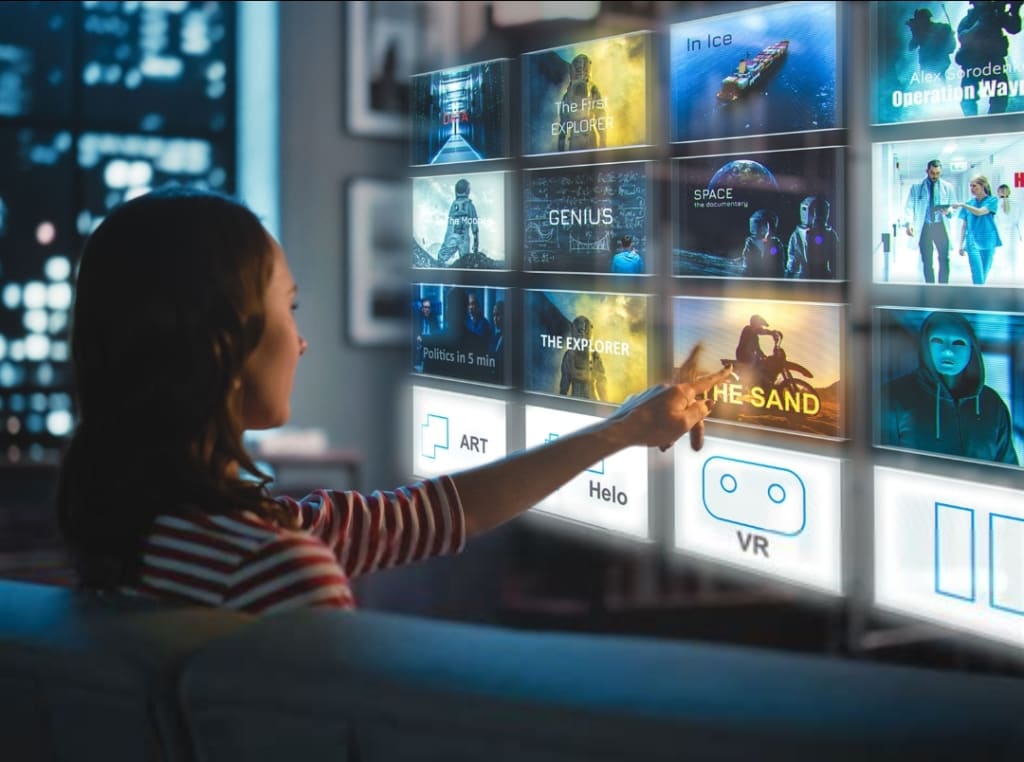Over the last two decades, the entertainment landscape has undergone a radical transformation, largely driven by the rise of streaming services. From television and movies to music and live events, streaming platforms have fundamentally altered the way content is consumed, produced, and distributed. The advent of platforms such as Netflix, Spotify, Hulu, and YouTube has disrupted traditional entertainment models, challenging established industries like cable television, movie theaters, and music distribution.
In this article, we will explore how streaming services have reshaped modern entertainment, examining the evolution of streaming platforms, the shift in consumer behavior, the impact on content creation, and the future of this ever-growing industry.
1. The Evolution of Streaming Services
1.1 The Early Days: From DVD Rentals to Digital Streaming
The roots of streaming services can be traced back to the early 2000s, when companies like Netflix and Blockbuster began offering home video rentals. However, it was Netflix’s pivot from a DVD rental model to online streaming in 2007 that marked the beginning of a new era. At the time, broadband internet connections were becoming more widely available, and Netflix saw an opportunity to tap into this growing infrastructure.
In the years that followed, Netflix grew rapidly, offering subscribers unlimited access to a wide range of movies and TV shows. Streaming on-demand content allowed consumers to bypass traditional cable television and enjoy entertainment whenever and wherever they wanted, marking the beginning of the “binge-watching” culture.
As broadband speeds improved, more companies entered the streaming market. Amazon Prime Video, Hulu, Disney+, and a host of other services began offering unique content and subscription models, further accelerating the industry’s growth. Today, streaming services are not only competing with traditional television networks, but they are also creating original content, disrupting the entire entertainment ecosystem.
1.2 The Subscription-Based Model: Shifting Away from Cable
One of the defining features of modern streaming services is their subscription-based model. This model allows consumers to access a vast library of content for a monthly fee, with no long-term contracts or installation fees. For many viewers, this has become a more cost-effective and flexible alternative to traditional cable packages, which often come with high prices, long-term commitments, and unnecessary channels.
Additionally, streaming services provide a level of personalization that cable television simply cannot. Algorithms suggest content based on viewing history, preferences, and genres, allowing users to discover new shows and movies with ease. This customization has become a key selling point, with services like Netflix and Spotify leveraging data to curate content recommendations that cater to each individual user’s tastes.
2. The Impact on Content Consumption
2.1 Binge-Watching and On-Demand Viewing
One of the most profound effects of streaming services has been the cultural shift toward binge-watching. The ability to stream entire seasons of TV shows at once has revolutionized how audiences consume content. No longer do viewers have to wait week by week for new episodes of their favorite shows. Instead, they can watch multiple episodes (or even entire seasons) in a single sitting.
This shift has also influenced the way shows are structured. Streaming platforms like Netflix often release episodes all at once, while traditional TV networks typically release episodes on a weekly schedule. As a result, show creators have adapted their storytelling styles, often crafting shows with cliffhangers or serialized plots that encourage viewers to keep watching.
Additionally, the on-demand nature of streaming allows for greater flexibility in how viewers engage with content. Whether it’s pausing mid-show, skipping over intro sequences, or watching content across multiple devices, streaming services empower users to take control of their viewing experience.
2.2 Global Accessibility and Diverse Content
Another major shift that streaming services have brought to entertainment is the global accessibility of content. Platforms like Netflix and Amazon Prime Video have enabled viewers from around the world to access a massive library of international content. The globalization of streaming has broken down geographic and cultural barriers, exposing audiences to a broader range of movies, TV shows, and documentaries from different countries.
This has also led to a greater demand for diverse content. For example, Netflix has invested heavily in producing original content across different languages and cultures, such as “Money Heist” from Spain and “Sacred Games” from India. This global approach to content has helped push the boundaries of traditional entertainment and has made streaming services a platform for more inclusive, diverse, and culturally rich storytelling.
3. The Impact on Content Creation and Distribution
3.1 The Rise of Original Content
One of the most notable shifts in the entertainment industry has been the increased investment in original content by streaming services. Platforms like Netflix, Hulu, Disney+, and Amazon Prime have become not only distributors of existing content but also major producers of original programming. Shows like “Stranger Things”, “The Crown”, “The Mandalorian”, and “The Boys” have garnered massive global followings and received critical acclaim.
This trend of producing exclusive, high-quality content has forced traditional Hollywood studios and television networks to rethink their strategies. Streaming services have disrupted the traditional model of content creation by allowing for more creative freedom, risk-taking, and quicker turnarounds on content. With a vast global audience and direct-to-consumer access, these platforms have the freedom to experiment with niche genres and formats that might not succeed in a traditional cinema or broadcast setting.
3.2 Changing Distribution Models and Day-and-Date Releases
Streaming platforms have also changed the distribution models for movies and television shows. Traditional movie releases were often confined to theaters first, followed by DVD releases, cable television airings, and digital rentals. However, streaming platforms like HBO Max and Disney+ have embraced the day-and-date release model, releasing movies on their streaming platforms simultaneously with their theatrical debut.
This has led to a dramatic shift in how films are viewed. With the rise of streaming, audiences can now watch the latest blockbuster movies from the comfort of their homes, rather than waiting for DVD releases or cable airings. While this has caused disruption in the box office and movie theater industries, it has also led to more accessible content and a broader reach for films and documentaries.
4. The Economic and Cultural Impact of Streaming Services
4.1 Changing the Business of Entertainment
The rise of streaming services has led to a significant shift in the economics of the entertainment industry. By cutting out middlemen like cable providers, studios, and television networks, streaming platforms have taken a more direct role in content creation, distribution, and consumption. This shift has increased competition within the industry and forced traditional players to adapt to the new digital-first environment.
Subscription-based revenue models allow streaming services to bypass the traditional advertising-driven business model of television networks. For example, Netflix generates revenue solely from subscriptions, while Hulu and Amazon Prime Video use a combination of subscription fees and ad-supported content.
Streaming services have also created new opportunities for smaller production companies and independent creators. With lower entry barriers, content creators can now get their work directly in front of global audiences, bypassing the need for major studio backing. This democratization of content distribution has led to a surge in independent and niche content that might not have made it through traditional media channels.
4.2 Impact on Traditional Entertainment and Job Markets
The shift towards streaming has had a significant impact on traditional forms of entertainment. Movie theaters, once the dominant method for watching films, have seen a decline in revenue as audiences increasingly opt for the convenience and affordability of streaming platforms. Similarly, cable television has experienced a sharp decline in subscriptions, as viewers abandon traditional programming in favor of more flexible streaming options.
Additionally, the rise of streaming services has created new job markets within the entertainment industry. From content creators and marketers to software engineers and data scientists, streaming platforms rely on a diverse workforce to operate and innovate. The demand for skilled professionals in areas like artificial intelligence, machine learning, and content recommendation algorithms is growing as streaming platforms seek to improve user experience and content discovery.
5. The Future of Streaming Services
5.1 Increased Competition and Consolidation
As the streaming landscape continues to evolve, it is expected that the competition between platforms will intensify. With new players entering the market, such as Apple TV+, Peacock, and HBO Max, consumers now have a wider array of choices, each with its own unique library of content. However, this has also led to fragmentation, as users must subscribe to multiple services to access all their favorite content.
This fragmentation may lead to consolidation in the future, where some services may merge or form partnerships to offer comprehensive content libraries. Alternatively, some platforms may move towards more specialized niches, catering to specific genres or interests.
5.2 Technological Advancements and Interactive Content
The future of streaming will likely see continued innovations in technology. As broadband speeds improve and the use of 5G networks increases, the quality of streaming content will continue to improve, offering higher resolution formats like 4K and 8K. Additionally, interactive content, similar to Netflix’s “Bandersnatch”, will become more prevalent, allowing viewers to choose the direction of a story or interact with content in new ways.
Streaming platforms may also incorporate augmented reality (AR) and virtual reality (VR) to offer immersive entertainment experiences that transport users into virtual worlds. As technology evolves, the line between digital content and reality will continue to blur, offering exciting new possibilities for entertainment.
6. Conclusion
The rise of streaming services has fundamentally reshaped the entertainment industry, offering consumers more control, flexibility, and access to content than ever before. With the ability to watch movies, TV shows
, and listen to music on-demand, streaming platforms have replaced traditional television, cinema, and music distribution models.
These platforms are driving a new era of content creation, fostering global access to diverse stories, and disrupting traditional business models. As the streaming landscape continues to evolve, consumers will benefit from more choice, greater personalization, and cutting-edge technological innovations. The future of entertainment is digital, and streaming services are leading the way.
Key Takeaways
- Streaming services have revolutionized how content is consumed, offering on-demand access and encouraging binge-watching culture.
- Subscription models, personalization, and diverse content have shifted the entertainment landscape away from traditional cable television and movie theaters.
- The rise of original content and day-and-date releases has empowered streaming platforms to become powerful content producers.
- The growth of streaming has disrupted the economics of traditional media, creating new business models and job opportunities.
- The future of streaming will likely include increased competition, consolidation, and technological innovations like 5G, AR, and VR, creating more immersive and interactive experiences for viewers.

